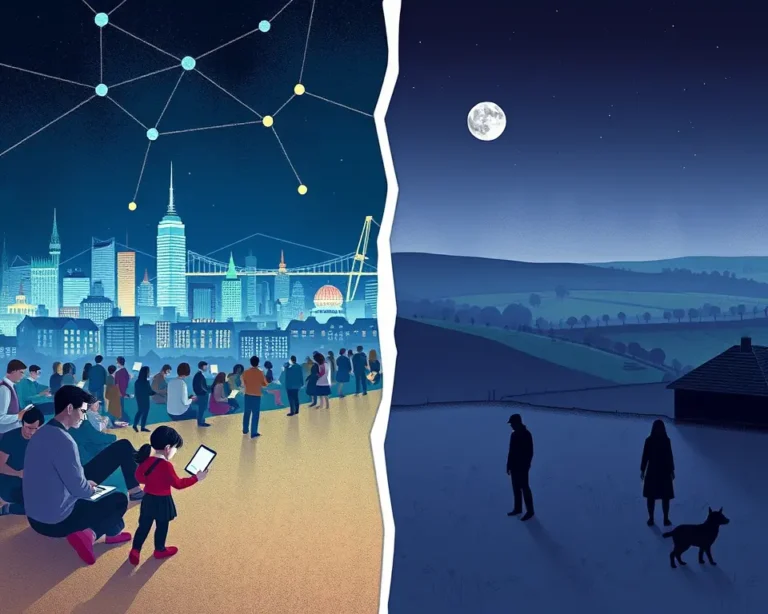The digital divide in the UK, characterized by unequal access to digital technologies and the internet, is increasingly recognized as a critical factor impacting mental health and well-being. This divide exacerbates existing social and economic disparities, leading to feelings of isolation, anxiety, and exclusion for those left behind in an increasingly digitized world. While the internet offers numerous benefits, including access to mental health services and social connections, the reality is that a significant portion of the UK population lacks the necessary skills, access, or affordability to fully participate, leading to profound mental health consequences.
Understanding the UK’s Digital Divide
The digital divide refers to the gap between individuals who have access to and can effectively use digital technologies, and those who do not. In the UK, this divide is multifaceted, influenced by factors such as income, age, education, disability, and geographical location.
- Statistics Snapshot: Several key statistics highlight the depth of the digital divide in the UK:
- 8.5 million people lack basic digital skills ([4]).
- 3.7 million families are below the Minimum Digital Living Standard, facing barriers like limited internet connectivity and outdated devices ([4]).
- 24% of adults classify themselves as digitally excluded in some form, with higher rates among 18-24 year olds (42%) and those aged 75 and over (30%) ([7]).
- 44% of adults with a household income of under £10,000 identify as digitally excluded ([7]).
- 1.5 million UK households have no internet access ([10]).
- 2 million UK households struggle to afford internet access ([10]).
These statistics illustrate that digital exclusion is not just about access to technology but also about affordability, skills, and confidence in using digital tools.
Factors Contributing to Digital Exclusion
Several factors contribute to the digital divide in the UK, creating a complex web of barriers for certain population groups.
- Income: Lower-income individuals and families often lack the financial resources to afford devices, internet subscriptions, and digital skills training ([5, 7]).
- Age: Older adults, particularly those over 75, are more likely to be digitally excluded due to a lack of digital skills and confidence ([2, 7, 13]).
- Disability: Disabled adults are more likely to experience digital exclusion due to accessibility issues and a lack of tailored support ([13, 17]).
- Geographical Location: Rural and remote areas often have limited broadband infrastructure, making it difficult for residents to access reliable internet services ([5, 6]).
- Education: Individuals with lower levels of education may lack the digital literacy skills necessary to navigate online resources and services ([16, 24]).
- Mental Health Difficulties: People with severe mental illnesses may face additional barriers to digital engagement due to symptoms such as psychosis, paranoia, and depression ([14, 35]).
The “Digital Inverse Care Law”
The concept of the “digital inverse care law” highlights that those who most need the benefits of digital health tools are the least likely to be able to access them ([35]). This is particularly concerning for people with severe mental ill-health (SMI), who are at greater risk of being digitally excluded and may have poorer access to digital technology or lack the skills and confidence to do things online ([28]).
Mental Health Consequences of Digital Exclusion
Digital exclusion has significant mental health consequences, exacerbating existing inequalities and creating new challenges for vulnerable populations.
Increased Social Isolation and Loneliness
- Loss of Social Opportunities: Without access to digital technologies, people can miss out on social opportunities and feel isolated, unable to communicate with loved ones or participate in online communities ([5, 6]).
- Exacerbation of Social Isolation in the Elderly: The digital divide can worsen social isolation in the elderly, as they may struggle to use digital tools to connect with others and maintain social relationships ([9]).
- Emotional Detachment: Exclusion from social media platforms can lead to emotional detachment, as individuals miss out on the connection, community, and mental health awareness content available online ([11]).
Heightened Anxiety and Depression
- Feelings of Frustration and Hopelessness: Digital exclusion can lead to feelings of frustration, loneliness, shame, and hopelessness, contributing to anxiety and depression ([11]).
- Increased Anxiety Among African Americans: The digital divide has been linked to rising levels of anxiety among African Americans, exacerbating existing social and economic disparities ([6]).
- Elevated Risk of Depressive Symptoms in Older Adults: Older adults who lack internet access are at a significantly higher risk of developing depressive symptoms, especially those with limited familial support or lower income levels ([21]).
Reduced Access to Mental Health Services
- Digital-First or Exclusively Online Services: Many mental health services are now digital-first or exclusively online, creating a barrier for those without digital access ([11]).
- Difficulties Accessing Online Support: The inability to access online support, engage with others socially, or stay informed can intensify feelings of isolation and reduce quality of life ([11]).
- Delays in Diagnosis and Treatment: Lack of access to digital resources can lead to delays in diagnosis, treatment, and ongoing care for mental health conditions ([6]).
Impact on Specific Groups
- People with Severe Mental Illness: A stark digital skills deficit among people with severe mental illness means they struggle to access key services which are increasingly online, leading to greater social isolation ([3]).
- Adolescents: Digital exclusion predicts worse mental health among adolescents, particularly during periods of school closures and social restrictions ([32]).
- Students: Lack of technological skills and expertise contributes drastically to the digital divide, which ultimately leads to social exclusion for some students ([16]).
Addressing the Digital Divide and Promoting Mental Health
Addressing the digital divide requires a multi-faceted approach involving government, industry, and community organizations.
UK Government Initiatives
- Digital Inclusion Action Plan: The UK government has launched a Digital Inclusion Action Plan to improve digital skills and accessibility, with support from Google, BT, and Vodafone ([8, 12, 25]).
- Digital Inclusion Innovation Fund: The government will launch an ambitious Digital Inclusion Innovation Fund to support local initiatives that increase digital participation ([25]).
- Device Donation Scheme: A pilot proof-of-concept multi-department device donation scheme with the Digital Poverty Alliance will provide re-purposed government laptops to those that need them ([25]).
Initiatives by Organizations
- Good Things Foundation: This organization works to help everyone become digitally equal, able, and safe, offering services like the National Digital Inclusion Network, National Databank, and National Device Bank ([4, 27]).
- Lloyds Banking Group, Vodafone UK, and Assurant: These companies have funded the Digital Inclusion Initiative (DII) in partnership with Liverpool City Region Combined Authority, providing tablets, connectivity, and digital skills training to digitally excluded individuals ([19, 25]).
- techUK: This organization advocates for a ‘digital for everyone’ inclusion strategy and works with members to deliver digital skills support and provide devices and data to tackle data poverty ([8]).
Recommendations
- Promote Digital Literacy: Increase investment in digital literacy programs to help people develop the skills they need to use digital technologies effectively and safely ([5, 9]).
- Ensure Affordable Access: Provide public financial support towards the costs of broadband connectivity and devices to improve access and affordability for low-income groups ([2, 17]).
- Address Accessibility Barriers: Ensure that digital mental health services are accessible to people with disabilities, with considerations for language barriers and mental health difficulties ([17]).
- Raise Awareness: Increase awareness of the digital divide and its impact on mental health among health and social care staff ([35]).
- Personalized Learning Formats: Provide personalized learning formats tailored to individual knowledge gaps and preferred learning styles ([14]).
- Promote Social Prescribing: Use social prescribing to help digitally excluded people access devices, data connectivity, and digital skills support ([31]).
- Address the Broader Political, Societal, and Economic Inequalities: Address and understand the social, political, and economic issues that influence digital inequities ([30]).
The Role of Social Media
Social media plays a dual role in the context of the digital divide and mental health. While it can be a source of connection and support for some, it can also exacerbate feelings of exclusion and inadequacy for those who are digitally excluded ([11, 33, 36]).
Positive Impacts
- Connection and Community: Social media platforms can offer connection, community, and access to mental health awareness content ([11]).
- Access to Information: The internet has made it easier for people to access information about mental health issues and connect with others who are going through similar experiences ([36]).
- Online Support Groups: Online support groups and forums can provide a sense of community and help people feel less isolated ([36]).
Negative Impacts
- Feelings of Inadequacy and Low Self-Esteem: Internet use can contribute to feelings of inadequacy and low self-esteem, as youth are often exposed to idealized and unrealistic portrayals of other people’s lives ([36]).
- Exposure to Harmful Content: The internet can expose people to harmful content, such as cyberbullying, hate speech, and violent or graphic images, triggering trauma, anxiety, and depression ([36]).
- Digital Burnout: Ironically, the same platforms that contribute to digital burnout for some can also serve as lifelines for others ([11]).
Conclusion
The digital divide in the UK is a significant social and health issue with far-reaching consequences for mental well-being. Addressing this divide requires a concerted effort from government, industry, and community organizations to ensure that everyone has the access, skills, and confidence to participate in the digital world. By promoting digital inclusion, we can create a more equitable society where everyone has the opportunity to thrive, both online and offline. It is also important to remember that while increased connectivity and access to online resources can improve mental health, constant connection to the digital world can also have negative effects, and individuals should find a balance that works for them, while keeping in mind available resources and mental health support.







